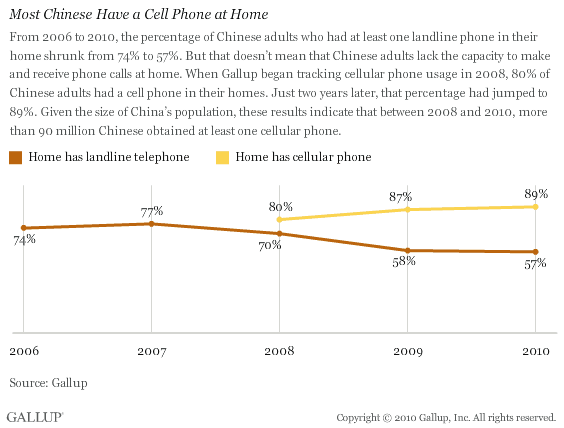There was a time when you could gauge a country's level of modernization by its spread of telephone poles. Those days are gone, and China illustrates just how much the world of telephonic connectedness has changed.
If you were to look only at landline phones in Chinese homes, you'd see a picture of declining interconnection. For example, Gallup surveys in China reveal that almost three-fourths (74%) of Chinese adults had at least one landline phone in their homes in 2006. But that percentage had shrunk, almost amazingly, to 57% in just four years. Does this mean that nearly 180 million Chinese adults now lack the capacity to make and receive phone calls at home? Hardly.
The mobile phone is not a luxury in China. It's viewed as a necessity.
It seems that while China has stopped stringing wires, it has simultaneously been building cell towers. As a result, there's been a remarkable explosion in the penetration of cellular phones, and the end is not in sight. In 2008, 80% of Chinese adults had a cell phone in their homes. Just two years later, that percentage had rocketed to almost 90% (89%). These increases are impressive, especially when viewed in light of China's enormous population. These results indicate that between 2008 and 2010, more than 90 million Chinese obtained at least one cellular phone.
The size of this actively expanding market is certainly sufficient to set manufacturers like Nokia, Samsung, and Motorola scurrying to capture a chunk of these attractive potential sales. It's also seriously challenging the capacity of service providers such as China Mobile and China Unicom.

Not just for the young
In China, mobile phones are where you'd expect to find them, but also, and more compellingly, where you might not. As is true in the rest of the world, ownership of cell phones among the young is highest. In fact, cell phone penetration is almost total with this group; in 2010, 96% of Chinese aged 15 to 29 had a mobile phone at home. But more than three-fourths (76%) of those aged 55+ also had a mobile phone at home -- a percentage that quite markedly increased from the 61% noted two short years before. Clearly, this is not a product/service that's used and embraced only by the young.
In addition, while cell phone penetration in urban areas is higher than in rural regions, the differences are hardly as dramatic as one would expect. In 2008, almost 90% (89%) of urban Chinese could boast having a mobile phone at home. That number has continued to grow, and in 2010, 92% reported having cell phones.
Now contrast that with rural areas, where the image of traditional farming communities might imply a slow adoption of cellular technology. In 2008, less than three-fourths (73%) of rural Chinese had a cell phone at home. But that number is now approaching 90% (87%). The challenge in marketing to Chinese consumers lies not just in serving the needs of the big cities. The countryside seems to be bursting with opportunity, although this opportunity can only be addressed by considering the logistical requirements of distributing to and serving a dauntingly widespread marketplace.
Importantly, the mobile phone is not a luxury in China. It's viewed as a necessity. Among those Chinese who reported in 2010 that they're "finding it very difficult to get by" on their present income (8% of all Chinese), three-quarters (75%) told Gallup that they have at least one cell phone at home.
Here comes the Internet
If the cell phone is there, can the smart phone be far behind? There are indications that the future in China lies not merely in chatting over the phone but also in surfing the Web. And in this area, the growth has been equally impressive. In 2006, 9% of Chinese reported having home Internet access. That number increased to 14% in 2008, then to 27% in 2010. Again, the size of this growth must be considered in the context of the vast number of Chinese consumers. In only four years, more than 180 million Chinese adults gained access to the Internet at home. By way of comparison, that number is more than the total adult population of the United Kingdom, Germany, and France combined. In fact, the number of adult Internet users in China is more than the total adult population of the United States. Significant? Try mind-boggling.
China could become the world's third largest advertising market by 2011.
Internet penetration in China is predictably skewed toward certain groups: It's highest among those who are younger, more affluent, better educated, and urban -- especially those living in big cities. But while more than 4 in 10 (42%) Chinese aged 15 to 29 have Internet access in their homes, so do 14% of those aged 55+. And, while 43% of urban households had Internet access in 2010, so did 15% of those living in rural areas. Perhaps more surprising, Internet penetration in rural areas shot up from a mere 1% only five years previously. With apologies to songwriters Young and Lewis, "How ya gonna keep 'em down on the farm (after they've surfed Paree)?"
The changes that will be wrought by an interconnectedness that encompasses the old as well as the young and the rural as well as the urban have yet to be fully understood. Just as one example, mobile phones and mobile access create the basics needed for mobile marketing. Will the rise of the mobile Internet mean that China might bypass a good deal of traditional bricks-and-mortar retailing in much the same manner as it sidestepped telephone poles and house-to-house phone wiring?
The potential implications for marketing to the Chinese, whether by Chinese companies or Western ones, are particularly intriguing. Even within the sphere of linked communications devices, there's much more to be sold than cell phones. There are smart phones and netbooks. There's also the possibility of marketing through social media, such as Twitter and Facebook. And, above all else, there's the lure of the unparalleled size and scope of the Chinese market.
According to Advertising Age, China currently accounts for just 5% of total ad spending. But some have forecast that advertising spending in China will surpass that of Germany by 2011, making China the world's third largest advertising market.
Companies around the globe are busily gearing up for this future. Starbucks reportedly plans to triple its presence in China, with new outlets and new products. And no self-respecting global marketer wants to be left behind. The times, it appears, are not only a-changin', but they'll continue to do so in ways that can only be imagined.
Companies cannot afford to be lured simply by the market's huge size while ignoring the need to adapt to China's unique requirements as well as the need for efficient and effective marketing. There's money to be made, but there's also a great deal to be lost by unwary or unprepared marketers. So it's imperative that they closely monitor the developments in the Chinese market. China's consumers are changing and adopting -- and adapting to -- new technologies rapidly and in unprecedented ways. The new China is already starting to look a good deal different from the old.
